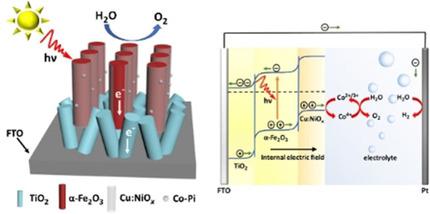当前位置:
X-MOL 学术
›
ChemSusChem
›
论文详情
Our official English website, www.x-mol.net, welcomes your
feedback! (Note: you will need to create a separate account there.)
Enhanced Photoelectrochemical Water Oxidation Performance in Bilayer TiO2/α-Fe2O3 Nanorod Arrays Photoanode with Cu : NiOx as Hole Transport Layer and Co−Pi as Cocatalyst
ChemSusChem ( IF 7.5 ) Pub Date : 2021-03-01 , DOI: 10.1002/cssc.202100363 Hongxing Li 1 , Meisong Yin 1 , Xianglin Li 2 , Rong Mo 1
ChemSusChem ( IF 7.5 ) Pub Date : 2021-03-01 , DOI: 10.1002/cssc.202100363 Hongxing Li 1 , Meisong Yin 1 , Xianglin Li 2 , Rong Mo 1
Affiliation

|
Efficient charge transfer and excellent surface water oxidation kinetics are key factors in determining the photoelectrochemical (PEC) water splitting performance in photoelectrodes. Herein, a bilayer TiO2/α-Fe2O3 nanorod (NR) arrays photoanode was prepared with deposited Cu-doped NiOx (Cu : NiOx) hole transport layer (HTL) and Co−Pi oxygen evolution reaction (OER) cocatalyst for PEC water oxidation. The hierarchical TiO2/α-Fe2O3 composite obtained by a secondary hydrothermal process exhibited an inapparent bilayer structure by embedding the underlayer TiO2 NR arrays at the bottom part of the post-grown α-Fe2O3 NR arrays. The underlayer TiO2 NRs acted as an effective shuttling pathway for transferring photoelectrons generated in the upper hematite light absorber layer. A p-type inter-Cu : NiOx HTL was introduced to form a build-in p–n electric field between Cu : NiOx and α-Fe2O3 NRs, which improved the hole extraction from α-Fe2O3 to Co−Pi OER catalyst. As expected, the as-engineered TiO2/α-Fe2O3/Cu : NiOx/Co−Pi photoanode displayed an excellent photocurrent density of 2.43 mA cm−2 at 1.23 V versus the reversible hydrogen electrode (VRHE), up to 4.05 and 2.23 times greater than those of the bare α-Fe2O3 (0.60 mA cm−2) and TiO2/α-Fe2O3, respectively. The results demonstrate that the bottom-up engineering of electron-hole transport channels and cocatalyst modification is an attractive maneuver to enhance the PEC water oxidation activity in hematite and other photoanodes.
中文翻译:

以 Cu: NiOx 作为空穴传输层和 Co-Pi 作为助催化剂的双层 TiO2/α-Fe2O3 纳米棒阵列光阳极中增强的光电化学水氧化性能
有效的电荷转移和优异的表面水氧化动力学是决定光电极中光电化学 (PEC) 水分解性能的关键因素。在本文中,双层TiO 2 /α-Fe 2 O 3纳米棒(NR)阵列光阳极由沉积的Cu掺杂NiO x(Cu:NiO x)空穴传输层(HTL)和Co-Pi析氧反应(OER)制备而成。 PEC水氧化的助催化剂。通过二次水热工艺获得的分层TiO 2 /α-Fe 2 O 3复合材料通过嵌入底层TiO 2表现出不明显的双层结构后生长的 α-Fe 2 O 3 NR 阵列底部的NR 阵列。底层 TiO 2 NRs 充当传输在上部赤铁矿光吸收层中产生的光电子的有效穿梭途径。引入 p 型 inter-Cu : NiO x HTL 以在 Cu : NiO x和 α-Fe 2 O 3 NRs之间形成内置 p-n 电场,从而改善了从 α-Fe 2 O 3 中的空穴提取Co-Pi OER 催化剂。正如预期的那样,设计的 TiO 2 /α-Fe 2 O 3 /Cu : NiO x/Co-Pi 光阳极在 1.23 V 下显示出优异的光电流密度,为 2.43 mA cm -2与可逆氢电极 (V RHE ) 相比,高达裸露的 α-Fe 2 O 3 (0.60 mA ) 的 4.05 和 2.23 倍cm -2 ) 和 TiO 2 /α-Fe 2 O 3。结果表明,电子-空穴传输通道和助催化剂改性的自下而上工程是增强赤铁矿和其他光阳极中 PEC 水氧化活性的有吸引力的策略。
更新日期:2021-03-01
中文翻译:

以 Cu: NiOx 作为空穴传输层和 Co-Pi 作为助催化剂的双层 TiO2/α-Fe2O3 纳米棒阵列光阳极中增强的光电化学水氧化性能
有效的电荷转移和优异的表面水氧化动力学是决定光电极中光电化学 (PEC) 水分解性能的关键因素。在本文中,双层TiO 2 /α-Fe 2 O 3纳米棒(NR)阵列光阳极由沉积的Cu掺杂NiO x(Cu:NiO x)空穴传输层(HTL)和Co-Pi析氧反应(OER)制备而成。 PEC水氧化的助催化剂。通过二次水热工艺获得的分层TiO 2 /α-Fe 2 O 3复合材料通过嵌入底层TiO 2表现出不明显的双层结构后生长的 α-Fe 2 O 3 NR 阵列底部的NR 阵列。底层 TiO 2 NRs 充当传输在上部赤铁矿光吸收层中产生的光电子的有效穿梭途径。引入 p 型 inter-Cu : NiO x HTL 以在 Cu : NiO x和 α-Fe 2 O 3 NRs之间形成内置 p-n 电场,从而改善了从 α-Fe 2 O 3 中的空穴提取Co-Pi OER 催化剂。正如预期的那样,设计的 TiO 2 /α-Fe 2 O 3 /Cu : NiO x/Co-Pi 光阳极在 1.23 V 下显示出优异的光电流密度,为 2.43 mA cm -2与可逆氢电极 (V RHE ) 相比,高达裸露的 α-Fe 2 O 3 (0.60 mA ) 的 4.05 和 2.23 倍cm -2 ) 和 TiO 2 /α-Fe 2 O 3。结果表明,电子-空穴传输通道和助催化剂改性的自下而上工程是增强赤铁矿和其他光阳极中 PEC 水氧化活性的有吸引力的策略。































 京公网安备 11010802027423号
京公网安备 11010802027423号